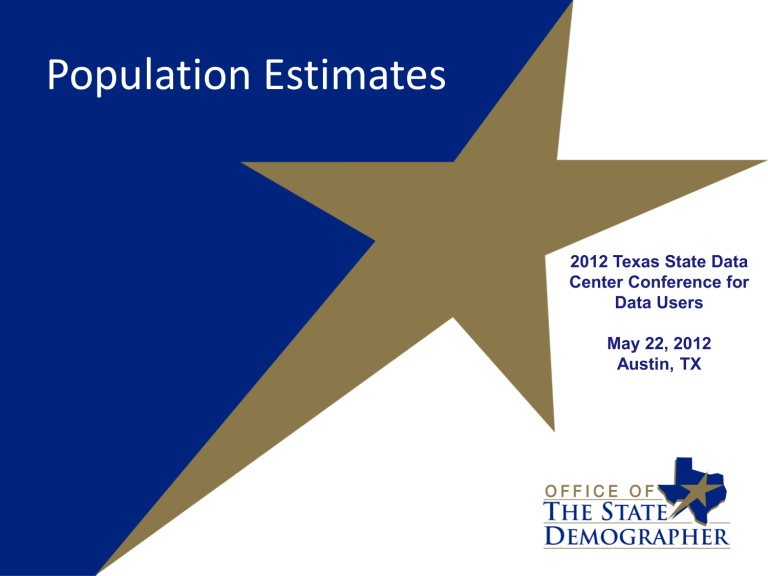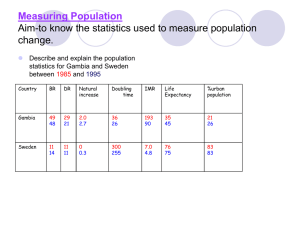Microsoft Powerpoint ( 2.0 MB )

Population Estimates
2012 Texas State Data
Center Conference for
Data Users
May 22, 2012
Austin, TX
Population Estimates
• size of the past or current population of a specific geographic area for which census counts are not available
• in lieu of an actual census count
• used to update population data gathered by the last census
Methods closely related to methods of population projections. projections focus on the future estimates mainly focus on the present or the recent past
Estimates based on observed data about population changes
(births, deaths and migration),
Projections are for dates with no observed data.
Estimates: Applications and Issues
• important contribution to the activities of governments, organizations, and businesses
– basis for allocating funds or determining major expenditure
– aid to understanding the nature of ongoing changes and their implications
– Federal, state, and local governments use them to establish electoral boundaries, to plan service delivery, and to determine the need for various types of public facilities.
– Business use population estimates to develop consumer profiles, to choose sites for new stores or branch offices, and to identify under-served markets.
– Researchers use them as rate denominators and to study social trends, environmental conditions, and geographic movements.
• difficult to complete with accuracy for small areas because small areas can grow or decline rapidly, or even undergo substantial changes in age, sex, and race/ethnicity, and other demographic characteristics.
Population Estimates
• Two types of estimates:
– Intercensal - estimates computed between two censuses, such as 2000 to 2010;
– Postcensal - estimates for dates after the most recent census.
Principles of Population
Estimates and Projections
An estimate or projection is as accurate as the assumptions on which it is based
No specific methodology guarantees accuracy
Estimates and Projections usually are more accurate for:
– Areas with large populations
– Total population
– Shorter time periods
– Areas with slow or stable growth patterns
Factors Limiting Estimation and Projection
Procedures and Uses
• Data Availability and Quality (Data Adjustments)
• Changes in Areal Boundaries
• Changes in Definitions
• Coverage Errors (undercount or overcount)
Common Data Adjustments Required in
Population Estimation and/or Projection
Adjusting period of estimate or projection from Census date
(April 1) to estimate or projection date (such as July 1)
Deriving values for parts of years from annual data (usually simply assume linear rate of occurrence; e.g., ¼ births occur by
April 1, ½ by July 1, etc.)
Adjust values of indicators for a jurisdictional area to be consistent with a Census area (e.g., adjusting data for school districts to be consistent with place boundaries)
Using averages of vital occurrences to increase the stability of rates for small areas
Estimation Methods
Extrapolative Techniques
– Arithmetic
– Geometric
– Exponential
Regression-Based Techniques
–
–
Ordinary Least Squares
Ratio-Correlation
Symptomatic Techniques
– Housing Unit Method
– Electric Meter Method
– School Enrollment Method
Component Techniques
– Cohort Survival Method
– Component Method II
– Administrative Records
Method – Simple Ratio Method
– Vital Rates method
– Composite Method
– Proration Method
Extrapolative Techniques
Techniques – use data on past trends in rates (or ratios) of population change to estimate total population
Only data requirement is for data on total population of estimate areas for at least two points in time
Easy to use but fail to take into account
Changes in population structure
Changes in component process (i.e., trends in births, deaths and migration)
Growth Models
Geometric Exponential
Arithmetic Rate of Change
Data Requirement
Total population counts or prior estimates for two or more previous time periods
Major Assumptions
Historical pattern of change applies to current measurement period
Population increase or decrease by the same number each year, (i.e., fixed numerical change)
Estimates of Population Based on
Arithmetic Growth Rate, 2000-2010 o
Where: P o
= Population at the base period (e.g., 2000)
P n
= Population at the end period
(e.g., 2010)
Annual Amount of Change b = b n
=
= Years between base period and end period
P n
P o n
P n
= Population for 2010
P
0
= Population for 2000
n = is the time in years
b =
25,145,561
10
20,851,820
4,29 3,741
10
429,374
For April 2011
P
2011
For July 2012:
P
2011
=
P
8
=
=
25,145,561
25,574,935
25,145,561
+ (429,374 x 1)
+ (429,374 x 2.25)
P
2012
= 26,111,65 3
The estimated mid-year population for Texas in 2012 is 2 6,111,653
Geometric Rate of Change
Data Requirement
Total population counts or prior estimates for two or more previous time periods
Major Assumptions
Population change varies by fixed time intervals
Historical rate of change applies to current measurement period
Where :
Estimates of Population Based on
Geometric Growth Rate, 1990-2000
P = P (1+r) n
P = Estimated Population at time n n
P o
= Inital Population
1 r = Annual Rate of Change n = Number of Years Between P and P n
Two most recent census population may be used to calculate rate of change r
n
P n
P o
1
For this example, log (1 + r) = that 1 + r = 10
0.0081317
log
25,145,561
20,851,820
10
= 1.018900
and or
= 0.0081317*, so r r r r
P n
P
2012
= 0.018900
10
25,145,561
20,851,820
-1 or,
25,145,561
20,851,820
1/10
-1
1.018900
1
.018900
P o
(1
r ) n
25,145,561 * (1.0189) 2.25
26 ,227,52 7
This results in an annual percent increase of 1.89 per year. The estimated population fo r July 2012 is 26, 227, 527.
Exponential Rate of Change
Data Requirement
Total population counts or prior estimates for two or more previous time periods
Major Assumptions
Population change occurs on a continuous basis (i.e., a continuous rate)
Historical rate of change applies to current measurement period
Where :
Estimates of Population Based on
Exponential Growth Rate, 2000-2010
P n
P o e r n
P = Estimated Population n
P o
= Base Population e = A Constant (2.71828) r = Annual Rate of Change n = Number of Years Between P and P n
Two most recent census population may be used to calculate an nual rate of change r
log
10
P
P o n
n log
10 e
For this example, r
log
10
25,145,561
20,851,820
10(.4342
942)
0.081317
4.342942
0.018724
P
2012
P
2010 e
25,145 ,561* (2.7182
8)
.
0.018724
(2.
25)
26,227, 551
This results in an annual increase of 1.8724 percent per year. This rate can be applied to the 2010 Texas census population
(formula 1) to estimate population for July 2012. The estimated
population for July 2012 is 26,227,551.
Estimates for July 1, 2011
Census Bureau Estimate
Arithmetic Estimate
Geometric Estimate
Exponential Estimate
25,674,681
25,682,279
25,741,022
25,741,035
Symptomatic Methods
Use data on a factor (symptom) thought to vary with population to estimate population
Data Requirement
Value of symptom for areas of interest for known date (usually last census)
Population value for areas of interest for known date (usually last census)
Value of symptom for areas of interest for estimate date
Major Assumptions
Assumes relationship between symptom and population remains consistent or changes in a known pattern over time
Censal-Ratio Method with Symptomatic Data
P n
S o
U
=
=
=
P o
=
P n
( S o
U )x
P
S o o
Population on Estimate Date
Symptom Value on Last Census
Net Change in Symptom from
Census to Estimate Date
Ratio of Persons Per Symptom
Censal-Ratio Method Using
Housing Permits
Data Requirement
Measure of persons per household at estimate date
Count of occupied housing units at estimate date (which includes use of prior census data and housing permits since census)
Major Assumptions
Assumes housing change is symptomatic of population change
Step 1.
Step 2.
Censal-Ratio Procedure with Housing Permit Date:
Estimate of Population
Apply the formula, where Po/Ho assumes no change in household size since the last census. This assumption should be tested, especially for ensuring years after 2002.
Where:
P n
=
=
P o
H o
Population for estimate date P n
P o
= Population in all housing units on the last census date
H o
=
U =
Occupied housing units on the last census date
Net change in occupied housing units betw een the census date and the estimate date
P o
H o
= Average number of persons per occupied housing unit at the last census date
Obtain the census count of the total population and total number of occupied housing units in the city on the census date.
P o o
(April 1, 2000) = 55,002 persons
H o o
(April 1, 2000) = 20,705 occupied units
Censal-Ratio Procedure, continued
Step 3.
Obtain the number of housing units added to the housing stock since the last census date.
Number of Housing Units Added to Housing Stock of Any City, Texas*
Type of Unit
Single Family
2000
80
2001
88
2002
(January - March)
175
Multiple Family
Mobile Home
0
17
0
76
Total 97 164
*Note that figures for 2000 and 2001 reflect 12 month periods.
0
189
364
Step 4.
Obtain the number of demolitions since the census date (April 1, 2000)
Demolitions 2000 2001
2002
(January - March)
26 23 22
Step 5.
Adjust the figures so they are comparable.
January 1, 2000- December 31, 2000
January 1, 2001- December 31, 2001
Census figures for April 1, 2000 included the housing changes for the period from January 1, 2000 to April 1, 2000 so units added in January,
February and March are included both in the census counts and in the housing stock data. These units (3/12 of all 2000 units) must be subtracted from the total.
Censal-Ratio Procedure, continued
Step 6.
Add total number housing units to housing stock from April 1, 2000 to December 31, 2000:
Step 7.
9/12 (80 + 0 + 17) = 73
Adjust number of demolitions similar manner. Adjusted demolitions from April 1, 2000 to December
31, 2000:
23 x 9/12 = 17
Step 8.
Step 9.
Step 10.
Step 11.
Step 12.
Step 13.
Add housing units added to housing stock since April 1, 2000:
73 + 164 + 364 = 601
Subtract demolitions since April 1, 2000 from the total units added since April 1, 2000:
601 - (17 +22 +26) = 536
Because we are interested in occupied units only, the number of vacant units must be subtracted from the total number of housing units. Assuming a vacancy rate of 10.0 percent, which was the local vacancy rate at the census date of April 1, 2000:
(536 x .10) = 482
Add total number occupied units on census date to number of occupied housing units added since
April 1, 2000 to determine total number of occupied housing units at estimate date, April 1, 2002.
20,705 + 482 = 21,187
Determine the average number of persons per household at the census date by dividing the population by the number of occupied housing units on the census date.
55,002 ÷ 20,705 = 2.65646
Compute estimate of population, April 1, 2002, by multiplying number of occupied housing units at estimate date by the average number of persons per household:
21,187 x 2.65646 = 56,282
Censal-Ratio Method Using
Electric Meter Counts
Data Requirement
Measure of persons per electric meter
Accurate count of active residential meters
Major Assumptions
Assumes the change in meter counts is symptomatic of population change
Censal-Ratio Method Using Electric Meter Billing:
Estimate of a city
Step 1.
Where:
Step 2.
The basic formula assumes no change in the ratio of persons served per electric meter since the last census date. An adjustment may have to be made because of reductions in master meters or in household size
P n
= P n
P o
M o
= Population for estimate date P n
P o
M o
=
=
Population on the last census date
Number of residential electric meter billings on the last census date
U = Net change in electric meter bi llings between the census date and the estimate date
P o
M o
= Ratio of persons per meter on the last census date
From the last census, obtain the population (e.g., 55,002), and from the utilities office obtain the total number of residential electric meter billings that were active on the last census date, adjusting as necessary for annexations.
Step 3. Determine the ratio of population per meter of the last census date (adjusting for annexations if applicable):
55,002 ÷ 20,547 = 2.6769
Step 4. Obtain the current number of active meters adjusting for vacant housing units with active meters, multi-family units using master meters, and annexations since the census date. The local electric/power company can provide this data for the month desired for the estimate date.
Active residential electric meter billings on April 1, 2002: 20,944
Step 5. Calculate the total population by multiplying the number of active meters on the estimate date by the ratio of population per meter: 20,944 x 2.6769 = 56,065
Information on number of vacant units which had active electric meters is often not available. Utilities representatives may be able to provide an estimate.
Potential Refinements in Use of Housing
Unit/Electric Meter Methods (Smith, 1986)
Separate estimates by housing type (single-family, multiplefamily, mobile homes and group quarters)
Use of current surveys to establish average household size and occupancy rates
Use of average o f multiple estimates made using building permits, electric meters, telephone connections, etc.
Use of ratios of indicators to total population rather than using change in indicators as a symptom of change in housing
School-Enrollment Ratio Method
Data Requirement
School enrollment, grades 2-8, for area of interest and for nation at a prior time and at estimate date
Total population for area of interest and for nation at a prior time period and national population on estimate date
Major Assumptions
Assumes that the ratio of age-specific school enrollment relative to total population remains comparable between U.S. and area of interest at any point in time
School-Enrollment-Ratio Method Used to
Estimate Population for Bexar County, 2006
A.
Bexar County
1. Census Population (April 1, 2000)
2. School Enrollment, Grades 2-8
(April 1, 2000) (Public and Private)
3. School Enrollment Ratio
(2) ÷ (1) = 3
B. Texas
4. Total Population, 2000 (April 1, 2000)
5. School Enrollment, Grades 2-8
(November, 2000)
6. School Enrollment Ratio
(5)
÷ (4) = 6
7. Total Population (July, 2006)
8. School Enrollment, Grades 2-8
(November 2006)
9. School Enrollment Ratio
(November 2006)
(8) ÷ (7) = (9)
C. Bexar County
10. Estimated School Enrollment Ratio
(November, 2001 - April, 2006)
[(9)
÷ (6)] x (3) = (10)
11*. School Enrollment, Grades 2-8
(November, 2001 - April, 2006)
(Public and Private)
12. Estimated Population for April, 2006
(11)
÷ (10) = (12)
1,392,931
11 177,072
0.127
20,851,820
2,617,210
0.126
23,507,783
2,862,839
0.122
0.123
193,282
1,571,398
Public school enrollment was derived after partialing out those students who were bused into the school district from outside city boundaries. It was assumed that this proportion remained constant between 2000 and 2006.
Simple Ratio Technique
Uses trends in ratios for multiple symptoms to estimate population
P t
2
i n
1
R i n
P t
1
Where :
P t
2
=
R i
I i ,t
2
I i ,t
1
P t
2
=
=
=
Estimate for area of interest for e stimate date
I i , t
2
I i , t
1
Indicator value of indicator i for estimate date
Indicator value of indicator i for known date (ear lier than estimate date)
Population for area of interest for known date
Simple Ratio Technique
Data Requirement
Data on indicators (symptoms) for known period and estimate date
Major Assumptions
Change in ratios for symptoms indicative of change in population
Example of Simple Ratio Technique
To estimate population of Bexar County for 2006
Given:
Population of Bexar County in 2000 = 1,392,931
Births in Bexar County in 2000 = 24,033
Births in Bexar County in 2006 = 26,471
Deaths in Bexar County in 2000 = 10,184
Deaths in Bexar County in 2006 = 10,630
R
1
Births
R
2
Deaths
P t
2
i n
1
R i
R
2 n
P t
1
P t
2
2
Population of Bexar County in 2006 = 1,494,079
Vital Rates Method
Uses crude vital rates for subarea and superarea and trends in rate for superarea to estimate population in subarea
Rl t
2
Rl t
1
( RS / RS ) t
2 t
1
Where :
Rl t
2
=
Rl t
1
=
RS t
2
=
RS t
1
=
Estimate of vital rate for local (sub) area for estimate date
V ital rate for local (sub) area for known date (usually last census)
Vital rate for "super" area for for estimate date
Vital rate for "super" area for known date (usually last census)
Vital Rates Method
Data Requirement
Vital events for subarea for known period of time (usually census year) and estimate year
Vital rates for subarea for known period of time
Vital rate for superarea for known period of time and estimate date
Major Assumptions
Change in vital events symptomatic of change in population
Change in vital rate from known date to estimate date for subarea is equal to the change for the superarea
Example of Use of Vital Rate Method
To estimate 2006 population for the Bexar County using birth rates
Given:
Crude Birth Rate in Bexar County in 2000
Crude Birth Rate in Texas in 2000
Crude Birth Rate in Texas in 2006
=
=
=
24,033
1,392,931
20,851,820
=
=
=
Births in Bexar County in 2006 = 26,471
Change in Bexar County Rate in 2000-2006
Rl
2006
Rl
2000
( RS / RS )
2006 2000
Rl
2006
.
01725
(.
01695 / .
01742 )
.
01678
26,471
Es timated Population for Bexar County in 2006 =
.01678
.
01725
.01742
.01695
Proration
Where :
P t
1 l
P t
2 t
1
S
=
=
=
=
=
Pl t
2
Pl t
1
PS t
1
PS t
2
Population counted in the last census
Population estimate
Census date
"Super" area
Local or subarea
Proration
(To obtain estimate for subarea from data for “super” area)
Data Requirement
Estimate for “super” area for estimation date
Ratio of subarea to superarea population for a period (usually most recent census)
Assumption
Historical ratio between subarea and superarea population remains the same or change in a known way
Example of Proration Method
To estimate population of Bexar County for 2006
Given:
Population of Bexar County in 2000
Population in Texas in 2000
Population Estimate for the
State in 2006
Pl t
2
=
= 1,392,931
= 20,851,820
= 23,507,783
Pl t
1
PS t
1
PS t
2
1,392,931
20,851,820
23,507,783 = 1,570,353
Estimated Population of Bexar County in 2006
= 1,570,353







